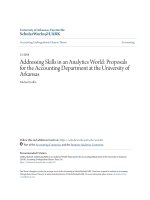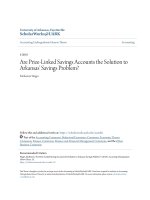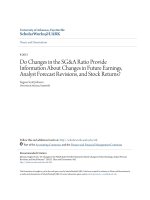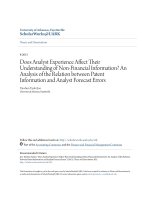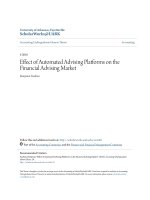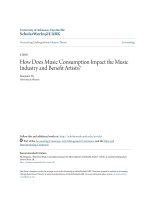Accounting undergraduate Honors theses: How relevant is the disclosure of a CEO pay ratio?
Bạn đang xem bản rút gọn của tài liệu. Xem và tải ngay bản đầy đủ của tài liệu tại đây (1.26 MB, 41 trang )
University of Arkansas, Fayetteville
ScholarWorks@UARK
Accounting Undergraduate Honors Theses
Accounting
12-2015
How Relevant is the Disclosure of a CEO Pay
Ratio?
Addison Stanfill
University of Arkansas - Main Campus
Follow this and additional works at: />Part of the Accounting Commons, Benefits and Compensation Commons, and the Finance and
Financial Management Commons
Recommended Citation
Stanfill, Addison, "How Relevant is the Disclosure of a CEO Pay Ratio?" (2015). Accounting Undergraduate Honors Theses. 19.
/>
This Thesis is brought to you for free and open access by the Accounting at ScholarWorks@UARK. It has been accepted for inclusion in Accounting
Undergraduate Honors Theses by an authorized administrator of ScholarWorks@UARK. For more information, please contact ,
How Relevant is the Disclosure of a CEO Pay Ratio?
Addison Stanfill, University of Arkansas
ABSTRACT
An aftershock of the so called “Great Recession” in 2008, the Dodd-Frank Wall Street Reform
and Consumer Protection Act effective July 21, 2010 aimed to increase the transparency of
public companies. Section 953(b) of this act is targeting the transparency of executive and
employee compensation by requiring the disclosure of a CEO to median employee pay ratio.
This disclosure requirement, set to affect all filings with a fiscal year beginning after January 1,
2017, was a response to the public outcry against excessive CEO compensation. Although it
does promote the transparency initiative of the Dodd-Frank Act, this disclosure may be wholly
unnecessary. Because total CEO compensation is already a required disclosure, this study is
examining the benefits and necessity of Section 953(b) by taking into account the driving force
behind the ratio and its effect on the business environment.
1
INTRODUCTION
An economy naturally undergoes periods of expansion and recession. This normal
business cycle is a consistent component of economies globally. During expansionary times,
output, employment, and inflation rise. Conversely, recessionary periods face falling output and
increasing unemployment (Romer). Although business cycles are ordinary trends, sometimes
the trends peak or pit to a greater magnitude than expected. Particularly during an excessive
pit, public dissent grows in strength pressuring politicians and businesses to reevaluate their
position and seek mediating solutions to the issues at hand. In December of 2007, the economy
underwent a downturn outside of normal conditions. Economic indicators fell beneath levels
expected during ordinary recessionary periods. This kicked off a period which ran until mid2009 known as the “Great Recession” (U.S Bureau of Labor Statistics). Consistent with previous
economic downturns of large magnitude, public outcry and dissent grew large. Government
and politicians were put under pressure to easing the swelling tide and provide constituents
with some relief from growing financial pain. The response came on July 21, 2010 when the
Dodd-Frank Wall Street Reform and Consumer Protection Act was passed.
The Dodd-Frank Act was the response to the “Great Recession” with the goal of
reducing the likelihood of a future recessionary period reaching such magnitude. This is widely
considered the most far reaching Wall Street reform in history specifically targeting abusive
financial practices and opaque business reporting (The White House). In conjunction with the
public disapproval of the recession, a growing number of companies began to come under fire
for their executive compensation packages. As a growing number of Americans became jobless,
2
or received reduced pay, CEO pay was growing from its already high levels. The combination of
opaque reporting and public discord with CEO pay led to the inclusion of Section 953(b) in the
Dodd-Frank Act. This section’s particular aim was to quell the popular demand that something
be done to regulate CEO pay.
CEO Pay Trends
CEO pay has been one of the hottest business topics in the recent past. Public outcry has
grown substantially over time requiring politicians to act and include the aforementioned
Section 953(b) in the Dodd-Frank Act. But why is this such a trending topic, and why do so many
people actually care?
People care about CEO pay trends, because they care about money. Every dollar going
to a CEO is a dollar not going to them or to someone else who goes to work every day just like
that CEO. And when that CEO is earning substantially more money than the average employee,
people tend to take exception. The argument is not that CEOs do not deserve to be the highest
paid employee at any given company, but rather that the CEO’s compensation is so far in excess
of average employees who are also vital contributors to the company.
Total CEO compensation has risen 937% since the late 70s to 2013 (Davis & Mishel).
Although that clearly is a large percentage, it gives you no context for how CEO pay has
progressed relative to compensation across the board. This is why the CEO to average
employee pay ratio has become an extremely popular piece of data and a vital piece of
evidence for those who speak out against excessive CEO pay. It provides a ratio describing the
amount of money made by a CEO for every dollar made by the “average” worker. As you can
3
see in the following figure, CEO’s were earning only $20 for every dollar earned by their
employees in the 1960s, and that jumped to $345 at the start of the recession (Davis & Mishel).
Furthermore, CEOs at the top 350 companies based on sales brought in on average
$16,316,000 in compensation in 2014 (Davis & Mishel). Compare that to the America’s average
salary in 2014 of $46,481 (Social Security Administration). Many have a hard time seeing the
equity in this type of pay disparity. This data helps to really put into context just how much
CEOs bring in every year, and why these trends have become a major hot button topic in the
general public. Politicians have identified the opinions of the public to take action as is their
4
duty, but maybe they should have recognized these trends or taken swifter action before it
created such a stir among the public.
CEO Pay Ratio Disclosure
Section 953(b) seeks to increase transparency in reporting and reign in CEO pay
practices to more reasonable levels by requiring the disclosure of a CEO to median employee
pay ratio in annual Securities and Exchange Commission (SEC) filings. This is similar to the ratio
used in the above discussion, except that instead of calculating an average compensation
amount, which is going to be greatly affected by several highly compensated employees, it will
use the median employee compensation which will generally be less than the “average”
employee. This particular section of the Dodd-Frank Act took over 5 years to actually be put
into effect. The SEC finally adopted this rule requiring the disclosure on August 5, 2015 after
months of deliberation and time for public comment. The disclosure will be required beginning
with companies whose fiscal year begins on or after January 1, 2017. As outlined by the SEC,
the new rule will require the following specific disclosures in annual filings:
The median of the annual total compensation of all its employees, except the CEO;
The annual total compensation of its CEO; and
The ratio of those two amounts (SEC)
The disclosure itself is highly controversial yielding strong opinions from politicians and
businesses. New Jersey Senator, Robert Menendez, the author of the disclosure, explains its
original goal of “injecting transparency, promoting fairness in Corporate America and restoring
sanity to runaway executive pay.” Senator Menendez further promotes the new rule by backing
5
its ability to be a powerful tool for investors who have the right to know the way a company
treats its “average workers” and its executives. Menendez was among many of the supporters
of this rule who were frustrated by the lack of urgency in its implementation. He states that the
“commonsense proposal never should have fallen victim to controversy (Menendez).”
Based on Senator Menendez’s remarks on the CEO pay ratio disclosure, the intent goes
beyond the transparency goal of the Dodd-Frank Act as a whole. This rule is aiming to reign in
“runaway executive pay.” Popular opinion agrees that CEO pay is extreme if not excessive, and
this leads into the broader, but related, issue of wealth distribution in America which goes
beyond the scope of this research. Up until this disclosure requirement there has been no
actual attempt at bringing CEO pay down. The hope is that the disclosure of the ratio will
publicly shame companies into either lowering executive compensation or raising regular
employee compensation (Eavis). Either of these alternatives will drop the CEO pay ratio, and
thus the intracompany wealth gaps. Companies will aim to adjust their compensation strategies
in order to avoid becoming the center of criticism and the face of wage inequality.
But contrary to Senator Menendez’s beliefs that this rule is commonsense, this rule has
controversy written all over it. Although public companies are required to file reports with the
SEC annually, they generally will not go above and beyond to provide information to users
outside of the requirements. As a point in case, during this research it was discovered that
corporations are not required to report total wages and salaries expense for the entire
company, and thus none of the companies in this research reported this data. Therefore, this
new disclosure was met with opposition by most corporations and politicians with a tendency
6
towards big business. An opposing SEC Commissioner, Daniel M. Gallagher, even called the rule
“the most useless of our Dodd-Frank mandates (Eavis).”
As of the time of writing, there is legislation in both the House and Senate aiming to repeal
Section 953(b) of the Dodd-Frank Act. Senator Mike Rounds of South Dakota is responsible for
the legislation in the Senate. Senator Rounds states that “the pay ratio rule is a waste of time,
effort and money, and the SEC is misguided in voting to adopt this duplicative, unnecessary
rule.” Rounds goes on by explaining that by repealing the disclosure rule, corporations can be
more productive without the wasted time and money (Rounds). On its face, the rule does not
seem to be so complicated and time-consuming, but the ratio is a much more difficult
calculation than it appears. The ratio which will have to be accurate, due to its inclusion in
financial statements, must take into consideration seasonal workers and wages for workers
around the world (Eavis).
Nonetheless, the disclosure requirement is happening, barring the success of the legislation
in works in both the House and Senate. Therefore businesses and investors need to be
prepared when it is time to start reporting and using the CEO pay ratio. What information will
this CEO pay ratio provide to business and to investors? As mentioned earlier, investors will use
the information as a measure in which to judge the treatment of the common employee.
Theoretically employees with higher pay are either more skilled or more motivated to perform
at a higher level. Investors will use this information to place pressure on organizations to
increase pay levels for the common employees in the hope of greater firm performance and
greater returns on their investment. Businesses on the other hand will use this disclosure to
compare compensation practices with their competitors. They will now be able to see how
7
much their competitors value their CEO relative to the common employee. The market for CEOs
is fiercely competitive, and this disclosure could actually lead to companies increasing CEO pay
to show they value their executives similarly to competitors. Whether or not the disclosure will
succeed in its intended purpose is up for debate and only time will tell if it can reach the goals
set out for it by its authors and supporters.
PROPOSITIONS
The CEO Pay Ratio is a fairly simple calculation. What is not so simple is the
aforementioned politics which engulf this controversial regulation. Something that has gone
unnoticed or unmentioned in all the debate surrounding this regulation is that total CEO
compensation is already a required disclosure. The argument that the disclosure requirement is
duplicative and unnecessary is clearly stated, but there is no backing as to why it is duplicative.
It could very likely be duplicative because the additional requirements calculating median pay
will provide very little additional information. When comparing the data on CEO compensation
and estimated median salary, it is clear that there is much greater variance in CEO
compensation. This means that CEO compensation should be the primary driver in determining
the CEO Pay Ratio. CEO compensation may be so strongly correlated with the CEO Pay Ratio
that the additional requirements requiring the disclosure of a median salary be unnecessary.
If this thought holds true, then that would mean that in addition median pay has little
influence in terms of driving CEO Pay Ratios. This disclosure which has been debated over so
vigorously may well be duplicative and unnecessary. If median pay has very little correlation
with the CEO Pay Ratio, there would be no true need behind including this disclosure assuming
8
that CEO compensation does correlate strongly with the ratio. If this were to hold true and the
disclosure requirement was actually repealed as is being currently attempted, companies can
be happy knowing that they will not have to provide the additional information in their annual
filings that they argue will come at such great expense of time and money. Additionally the
public can be happy because they can have all the information that they need already disclosed
annually. Those interested in the topic of CEO Pay Ratios should be able to simply evaluate total
CEO compensation to get the same information.
So what drives CEO compensation, and in turn, the CEO pay ratio? Could it possibly be
the size of the company based on measures such as total market capitalization? Or might it be
more financially based metrics such as price to earnings (P/E) ratio? Market capitalization has
been proven to be linked with CEO pay over time, and this can be easily noticed in the
compensation strategies of companies both currently and over time as firm size has increased
(Gabaix & Landier). This makes theoretical sense that the CEO over a higher valued firm should
be paid more than the CEO over a lower valued firm. Therefore it is predicted that firm size on
the basis of market capitalization will be strongly correlated with calculated CEO Pay Ratio.
Alternatively CEO compensation may be a related to measures of firm performance. If
firm performance drives CEO pay, and CEO pay drives the CEO Pay Ratio, then firm performance
must drive the ratio as well. A measure of firm performance is the price to earnings ratio which
measures the market value of a share of stock relative to its per-share earnings. CEOs are
almost always compensated in some way by equity in the firm. Companies in the S&P 500 are
reported to have made equity compensation over 60% of the total compensation given to
executives annually (Equilar). This equity is generally additional compensation on top of a base
9
salary for meeting performance metrics. CEOs aim for high performance metrics, such as
improving the price to earnings (P/E) ratio, because by doing so they will receive this additional
compensation in the form of equity. So as P/E ratio increases so will CEO pay, and as
mentioned above this rise in CEO compensation will drive the calculated CEO Pay Ratio.
A company’s industry may play into both the CEO’s compensation and subsequently the
ratio as well. Company pay practices tend to be heavily linked with an industry standard. CEOs
in a certain industry are likely to be compensated on a similar level to one another holding firm
size and performance equal. The reason for this is that companies compensate similarly in
order to hold on to their CEO, instead of losing them to a competitor who pays more. CEOs are
considered the top talent within a company, and by that thought they will be paid like the top
talent in order to protect against motivation for leaving the company. Within the data and the
CEO Pay Ratio there will likely not be much variation within each industry due to the fact that
the companies are constantly observing one another’s pay practices in order to maintain a level
of CEO pay that will mitigate the chances of losing this top talent. However there may still be
large variances between different industries as the threat of a CEO leaving a company to go to a
different industry is far less than that of the CEO moving within the industry. In terms of the
data set as a whole it is predicted that the range and variance will be much larger than those
found within any single industry, and much of the variance will be due to the different
industries in which the companies observed operate.
In summation of the above arguments, the following propositions were developed:
10
1. The CEO Pay Ratio is primarily driven by CEO pay. Because CEO pay is already a required
disclosure, the additional requirements for public filings is unnecessary.
2. Median pay has little influence on CEO Pay Ratios, and thus is an unnecessarily placed
burden upon companies.
3. The CEO Pay Ratio will be strongly correlated with the size of the firm measured by the
total market capitalization.
4. The CEO Pay Ratio will be strongly correlated with financial performance measures such
as the price to earnings ratio.
5. Classifying companies into broad industries will show that most of the variance in the
CEO Pay Ratio is between industries and not within each industry. It is predicted that the
variances within each industry will fall well beneath those of the data set as a whole.
METHODOLOGY
For this research, preliminary CEO Pay Ratios were calculated in accordance with SEC
requirements for companies in the Fortune 100 in 2014, the latest year of complete financial
data. These preliminary ratios are 2014 estimates of the ratio that will be required of public
companies beginning in 2017. To calculate the CEO Pay Ratio in accordance with the SEC’s
requirements, it is required to have an accurate calculation of total CEO compensation and the
median of the annual total compensation of all its employees. It is important that the CEO
compensation figure be representative of total compensation. Executives are awarded much
more in compensation than just a salary, which is often one of the lesser components of
compensation. Total compensation includes the sum of salary, stock options, bonuses, etc. that
change the financial position of the CEO.
11
Step one is gathering total CEO compensation for the companies of interest. Total CEO
compensation is readily available as it is a required annual disclosure in both the annual proxy
statement and the 10-K filing. Gathering this data involved using MergentOnline’s financial
statement accumulator database, identifying the company of interest and the executive of that
company considered to be the CEO, and recording his or her pay. Google’s CEO, Larry Page, was
excluded from the data as his total compensation for 2014 was only $1. This anomaly was
disregarded in the calculations and Google was removed from the data. All other CEO’s were
provided reasonable compensation that could be considered normal and acceptable for the
preliminary calculations.
Median employee compensation is not a required disclosure unlike CEO compensation.
This data can only be reasonably estimated based on the company and industry standards.
First, the company’s industry must be identified to estimate the type of jobs performed by the
company. Then there must be an estimate of the specific job that receives the median salary in
that company. This can be estimated through an examination of the size of the company and
the jobs that will make up a majority of their employees. Most companies will have a large
percentage of their employees performing a small percentage of the jobs. Job and industry
salary average information is available through O-net OnLine and the U.S. Bureau of Labor
Statistics respectively. If the job salary is within a reasonable range (around 20%) of the industry
average, then the estimated salary is considered acceptable. If not, then the above steps need
to be redone with the industry averages taken into consideration when identifying a new
median job. See Appendix Figure A which displays the positions and the median salaries used
12
for each company in this study. Below is a demonstration of how median salary was estimated
for a few companies:
Company- HP
Industry
Computer and Electronic Product Manufacturing
Estimated Median Job
Computer Engineer
Estimated Job Salary
$108,430
Estimated Industry Salary
$94,850 (difference of 12.5%)
Final Median Salary Estimate
$108,430
Company- Allstate
Industry
Insurance Carriers and Related Activities
Estimated Median Job
Insurance Examiner
Estimated Job Salary
$62,220
Estimated Industry Salary
$66,320 (difference of -6.5%)
Final Median Salary Estimate
$62,220
Glassdoor.com has also done similar research following the passing the new disclosure
requirement. Their calculated ratio reflects a differing method of estimating median employee
wages. Instead of estimating the median wage by company and industry, they developed
surveys which were sent out to employees in their population. They collected the responses
and for those companies with more than thirty responses, they found the median pay and used
13
that to calculate their CEO Pay Ratio. Their CEO compensation data reflects the last reported
year, which in most cases is the companies’ fiscal 2014, that is the same data as has been
gathered for this study. With their estimated CEO Pay Ratio and the CEO compensation used,
the median wages can be backed into. The Glassdoor data is presented in the appendix in figure
E. This data will also be utilized in the analysis to provide some comparison between the results
of this research and the Glassdoor data.
With both data in hand, calculating the CEO Pay Ratio involves dividing total CEO
compensation by the estimated median compensation. All skewed or kurtotic variables were
logged to facilitate more accurate analysis. What this in turn explains is how many dollars a CEO
earns in compensation compared to how many the average employee earns. So for example,
the calculated CEO Pay Ratio of Conoco Phillips is 323. For every $1 earned at the median job in
the company, the CEO is earning $323. This is a great measure of pay distribution and
compensation strategy, but not of equity. This ratio has no way of measuring the value of the
inputs provided by the CEO and the median employee. If the CEO is actually worth 323 times
the median employee to the company then this would be considered equitable, but
determining worth is not a component of this ratio. Below is the complete data and the
preliminary estimates of CEO Pay Ratio for the population of companies for which data was
collected.
14
DATA
*CEO Pay Ratio calculation in descending order by CEO Pay Ratio
Company Name
CVS Health
Target
TJX
Coca-Cola
Walmart
Disney
PespsiCo
Twenty-First Century Fox
Microsoft
Mondelez International
Macy's
Johnson & Johnson
Walgreens
Nike
Lockheed Martin
Kroger
Lowe's
American Express
Ford Motor
Exxon Mobil
Oracle
General Electric
Best Buy
Caterpillar
UPS
Philip Morris International
Comcast
Boeing
Time Warner
GM
Tyson Foods
Chevron
FedEx
Prudential Financial
Home Depot
Phillips 66
AT&T
Delta Air Lines
Halliburton
JP Morgan Chase
Honeywell International
Wells Fargo
Dow Chemical
Archer Daniels Midlands
ConocoPhillips
McKesson
CEO Compensation
$
32,350,733
$
28,869,024
$
28,692,391
$
25,224,422
$
19,392,608
$
46,497,018
$
22,485,574
$
29,247,871
$
84,589,838
$
21,039,946
$
16,197,220
$
61,989,306
$
13,654,636
$
16,819,730
$
33,687,442
$
12,987,582
$
14,279,945
$
22,796,083
$
18,596,497
$
33,096,312
$
67,261,251
$
37,250,774
$
12,937,294
$
17,131,448
$
16,994,449
$
14,124,869
$
32,961,056
$
28,861,920
$
32,903,139
$
16,162,828
$
12,173,164
$
25,970,417
$
13,807,175
$
37,483,092
$
10,171,865
$
24,507,433
$
23,984,315
$
17,589,867
$
20,560,157
$
27,701,709
$
29,142,121
$
21,426,391
$
26,698,372
$
9,181,378
$
27,575,900
$
24,844,555
Median Wages
$
19,060
$
19,060
$
21,390
$
23,610
$
19,060
$
47,890
$
23,610
$
36,560
$
108,430
$
27,590
$
21,390
$
85,400
$
19,060
$
23,610
$
48,430
$
19,060
$
21,390
$
34,550
$
28,370
$
53,160
$
108,430
$
61,580
$
21,390
$
28,370
$
28,370
$
23,610
$
55,190
$
48,340
$
55,190
$
28,370
$
23,610
$
53,160
$
28,370
$
78,620
$
21,390
$
53,160
$
55,190
$
42,290
$
53,160
$
78,620
$
83,060
$
62,620
$
79,930
$
27,590
$
85,400
$
77,550
CEO Pay Ratio
1697
1515
1341
1068
1017
971
952
800
780
763
757
726
716
712
696
681
668
660
655
623
620
605
605
604
599
598
597
597
596
570
516
489
487
477
476
461
435
416
387
352
351
342
334
333
323
320
15
Verizon
Merck
Marathon Petroleum
Morgan Stanley
Costco
Pfizer
American Airlines Group
Goldman Sachs Group
Sears Holdings
Safeway
Allstate
Bank of America Corp.
Deere
MetLife
Aetna
UnitedHealth Group
3M
Johnson Controls
General Dynamics
Cigna
Citigroup
HCA Holdings
Anthem
AIG
HP
DuPont
Humana
Express Scripts Holding
Cardinal Health
Intel
Plains GP Holdings
Apple
AmerisourceBergen
United Technologies
Ingram Micro
CHS
Tech Data
Cisco Systems
Sysco
World Fuel Services
Enterprise Products
Partners
Tesoro
Amazon.com
IBM
Procter & Gamble
DirecTV
Valero Energy
Energy Transfer Equity
INTL FCStone
Fannie Mae
$
$
$
$
$
$
$
$
$
$
$
$
$
$
$
$
$
$
$
$
$
$
$
$
$
$
$
$
$
$
$
$
$
$
$
$
$
$
$
$
$
17,541,509
25,029,370
16,401,255
23,270,044
5,622,927
23,283,048
12,301,976
22,162,912
5,702,364
4,993,657
15,641,385
15,342,399
20,273,296
15,163,803
15,067,322
14,856,321
20,115,589
19,540,681
19,388,084
14,461,445
14,457,199
14,625,534
13,532,549
12,064,428
19,641,164
14,159,638
10,255,401
12,921,006
12,448,618
11,197,400
7,454,118
9,222,638
9,902,985
8,986,174
8,382,223
6,764,456
7,616,942
10,295,279
7,815,394
7,706,999
6,654,846
$
$
$
$
$
$
$
$
$
$
$
$
$
$
$
$
$
$
$
$
$
$
$
$
$
$
$
$
$
$
$
$
$
$
$
$
$
$
$
$
$
55,190
79,930
53,160
78,620
19,060
79,930
42,290
78,620
21,390
19,060
62,220
62,620
83,060
62,220
62,220
62,220
85,400
83,060
83,060
62,220
62,620
66,640
62,220
62,220
108,430
83,060
62,220
79,930
85,400
77,550
53,160
77,550
85,400
83,060
77,550
66,640
77,550
108,430
85,400
85,400
85,400
318
313
309
296
295
291
291
282
267
262
251
245
244
244
242
239
236
235
233
232
231
219
217
194
181
170
165
162
146
144
140
119
116
108
108
102
98
95
92
90
78
$
$
$
$
$
$
$
$
$
1,600,000
1,681,840
1,600,000
1,250,000
1,700,000
1,250,000
1,275,154
1,157,607
750,000
$
$
$
$
$
$
$
$
$
23,160
24,430
29,910
23,610
55,190
53,160
85,400
78,260
62,620
69
69
53
53
31
24
15
15
12
16
Freddie Mac
United Continental Holdings
Berkshire Hathaway
$
$
$
750,000
269,782
464,011
$
$
$
62,620
42,290
78,620
12
6
6
*CEO Pay Ratio Data by Industry (SIC Divisions)
Industry
B
D
E
F
G
H
I
Avg CEO Pay
$ 17,222,934
$ 21,385,202
$ 15,346,853
$ 8,349,888
$ 14,823,863
$ 14,944,620
$ 19,179,463
Avg Median Wages
$
65,250
$
63,418
$
49,843
$
76,530
$
20,442
$
66,029
$
68,669
Avg CEO Pay Ratio
292
394
333
109
740
236
334
B- Mining and Extraction , D- Manufacturing , E- Transportation/Communication , F- Wholesale Trade ,
G- Retail Trade , H- Finance/Insurance , I- Services
Additional data relating to propositions can be found in the Appendix Figures.
ANALYSIS
This data set is difficult to interpret without some context behind the Calculated CEO
Pay Ratio. The table below outlines some of the most important summarizing figures for all of
the CEO Pay Ratios calculated.
Mean
Standard
Deviation
1st Quartile
Median
3rd Quartile
Max
Min
Range
393
326
146
296
599
1,697
6
1,691
17
To expand upon the data in the above table, it is clear to see that even among the top
hundred companies there is extreme variation among the calculated CEO Pay Ratio. The range
of the data alone paints a picture of this polarity. The top ratio belonging to CVS Health is 283
times larger than the smallest ratio held jointly by Berkshire Hathaway and United Continental
Holdings. Further the evidence that the ratios calculated vary significantly is highlighted by the
standard deviation of the ratios. With the average ratio landing at 393, the standard deviation
of 326 exhibits the polarity of this data. The largest five ratios exceed 1,000 and seventeen
companies have ratios which do not even break 100. Below each of the aforementioned
propositions are analyzed using the data gathered and estimates made.
The calculated data points to that clear fact that companies, even those expected to be
so similar due to their size, differ greatly based on compensation strategies. Those companies
with large ratios value their CEO and other leaders exponentially more than their median
employee. Investors and proponents of this disclosure requirement will take this as a sign of
unproductive and unsatisfied workers. That may be a sign of future employment issues such as
strike or increased employee turnover which could have financial implications. On the other
hand, people opposed to the disclosure rule will contend that the high ratio is indicative of the
industry and the type of work in which the company operates. Industry’s effect on the ratio will
be examined in the following section where each of the aforementioned propositions is
analyzed.
18
Proposition 1:
Predicting CEO Pay Ratio
Industry Controls
Market Capitalization
P/E Ratio
CEO Compensation
R2
Change in R2
Model 1
-
Model 2
.274*
Model 3
.275*
.167
Model 4
.004
.012
.876**
.136**
.203**
.067**
.227**
.025
.875**
.648**
Note: Standardized regression coefficients appear in table. Industry controls were used for 6 industries
because there are 7 industries total.
**- p < .05
*- p < .10
Correlation to CEO Pay Ratio
Market Capitalization
P/E Ratio
CEO Compensation
0.32
0.21
0.89
Above is the regression analysis from four separate regressions. Each regression is
identified as a model and each one adds new variables to the existing ones trying to predict the
CEO Pay Ratio. The rows with variables are displaying standardized regression coefficients. The
R2 in the table, otherwise known as the correlation coefficient, explains the proportion of the
dependent variable explained by the model. The correlation coefficient ranges from -1 to 1,
where a measure of 1 indicates a perfect positive correlation. Each model and its variables are
listed below, and these models will be the same throughout the analysis of all of the
propositions made:
Model 1- Industry (6 industries with SIC Division D as the base variable)
19
Model 2- Industry and Market Capitalization
Model 3- Industry, Market Capitalization, and P/E Ratio
Model 4- Industry, Market Capitalization, P/E Ratio, and CEO Compensation
Each model builds upon its predecessor by adding an additional variable which might help
to improve the prediction of the dependent variable, in this analysis CEO Pay Ratio. It was
predicted that CEO compensation would be the overriding driver of the CEO Pay Ratio. Based
on the data and estimates this appears to hold true. The first three models have correlation
coefficients which do not break .50 whereas the fourth model, and the only one with CEO
compensation as a variable has a R2 of .875. Further when looking at model 4, you can see that
CEO compensation is statistically significant at less than .05. CEO compensation proves again to
be a viable predictor in that as a stand-alone variable it has a correlation metric of .89. That
means that 89% of the CEO Pay Ratio can be explained solely by the CEO’s compensation.
The disclosure of additional information may very likely be unnecessary in terms of
evaluating the CEO Pay Ratio. If the already required disclosure, CEO compensation, is so highly
correlated the CEO Pay Ratio then it appears that the additional requirement to disclose
median pay may actually be providing only marginally more information. However, the
estimated CEO Pay Ratio used for this analysis was generated through estimates of the median
wages. As mentioned before, Glassdoor’s study went about a different method of coming to an
estimated median compensation. Below the same analysis will be performed using Glassdoor’s
CEO Pay Ratio as the dependent variable.
20
Predicting Glassdoor’s CEO Pay Ratio
Model 1
Industry Controls
Market Capitalization
P/E Ratio
CEO Compensation
R2
Change in R2
.106
Model 2
.050
Model 3
.181*
-.589**
Model 4
.068
-.466**
.460**
.109
.002
.350**
.242**
.538**
.187**
Note: Standardized regression coefficients appear in table. Industry controls were used for 6 industries
because there are 7 industries total.
**- p < .05
*- p < .10
Correlation to Glassdoor's CEO Pay Ratio
Market Capitalization
P/E Ratio
CEO Compensation
0.07
-0.31
0.5
As you can see from the data, the models are not as proficient at predicting the
dependent variable. The best model again is the fourth model which has the P/E ratio and CEO
compensation as significant variables. This model however only has a R2 .538, well below the
same model used to predict the CEO Pay Ratio calculated for this study. Additionally, CEO
compensation only correlates with Glassdoor’s ratio at .5. This again falls well beneath its
correlation with the ratio calculated by the median wage estimates in this study. It is interesting
to see that the P/E ratio comes into play as a predictor of Glassdoor’s ratio. A significant
variable in the fourth model, P/E ratio plays a part in the model whereas it was never close to
significant in the original analysis.
21
Proposition 2:
Correlation to CEO Pay Ratio
CEO Compensation
Median Wages
0.89
-0.38
Proposition 2 stemmed from its predecessor in that little additional information will be
made available by requiring companies to disclose supplementary financial figures. The
supplemental disclosure is median compensation. As noted in the analysis of the previous
proposition, CEO compensation correlates with the calculated CEO Pay Ratio by .89. This is very
nearly as good as it can get, so it would seem that requiring the disclosure of median
compensation is unnecessary. This is evident in the median wages only correlate -.38 to the
ratio. Only 38% of the ratio can reasonably be explained by median wages. This is not minimal,
and it can definitely be useful to know, but alone does not add much value. Therefore if CEO
compensation is known, an estimate of median compensation should suffice for understanding
the likely CEO Pay Ratio. For this to be done effectively, it must be determined what drives
median wages. Below is are three regression models attempting to predict median
compensation.
Predicting Median Pay
Industry Controls
Market Capitalization
P/E Ratio
R2
Change in R2
Model 1
-
Model 2
.026
Model 3
.026
-.006
.453**
.454**
.001
.454**
.000
22
Note: Standardized regression coefficients appear in table. Industry controls were used for 6 industries
because there are 7 industries total.
**- p < .05
*- p < .10
Correlation to Median Pay
Market Capitalization
P/E Ratio
-0.07
-0.16
Contrary to earlier investigation, the later models with more variables are not the best
predictors of median pay. Neither the addition of market capitalization or P/E ratio improve the
correlation coefficient from the first model. Further, Model 1 has a statistically significant R2.
Model 1 is the only model that should be used to predict median wages. Therefore, the
industries as a whole are a significant variable because they are the only variable in model 1.
Through association, industry drives median wages and median wages drive the CEO Pay Ratio.
Instead of adding median wages to the list of required disclosures, users of financial
information should only have to evaluate the industry to develop a sense for the median
compensation. The industry in which a company operates in combination with CEO
compensation should provide a sufficient estimate of the CEO Pay Ratio.
Predicting Glassdoor’s Median Wage
Industry Controls
Market Capitalization
P/E Ratio
R2
Change in R2
Model 1
-
Model 2
.164
Model 3
.121
.193
.159**
.184**
.025
.210**
.026
Note: Standardized regression coefficients appear in table. Industry controls were used for 6 industries
because there are 7 industries total.
23
**- p < .05
*- p < .10
Correlation to Glassdoor's Median Wage
Market Capitalization
P/E Ratio
0.15
0.06
Again, with the estimate of median wages, there is the possibility of error and this is an
inherent shortcoming of this analysis. To provide further evidence that industry is the best
predictor of median compensation Glassdoor’s research is applied to the regression models.
Again model 1 is the primary model of interest. The following models do not change R2
significantly. Although it is not highly correlated with Glassdoor’s median compensation,
industry division is a significant variable in predicting the median compensation just like it was
in the previous analysis. Therefore the assumption that industry is sufficient to understanding
median compensation is strengthened.
Proposition 3:
Predicting CEO Compensation
Industry Controls
Market Capitalization
P/E Ratio
R2
Change in R2
Model 1
-
Model 2
.308**
Model 3
.309**
.176
.045
.129*
.084**
.157*
.027
Note: Standardized regression coefficients appear in table. Industry controls were used for 6 industries
because there are 7 industries total.
**- p < .05
*- p < .10
24

